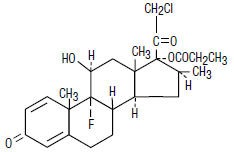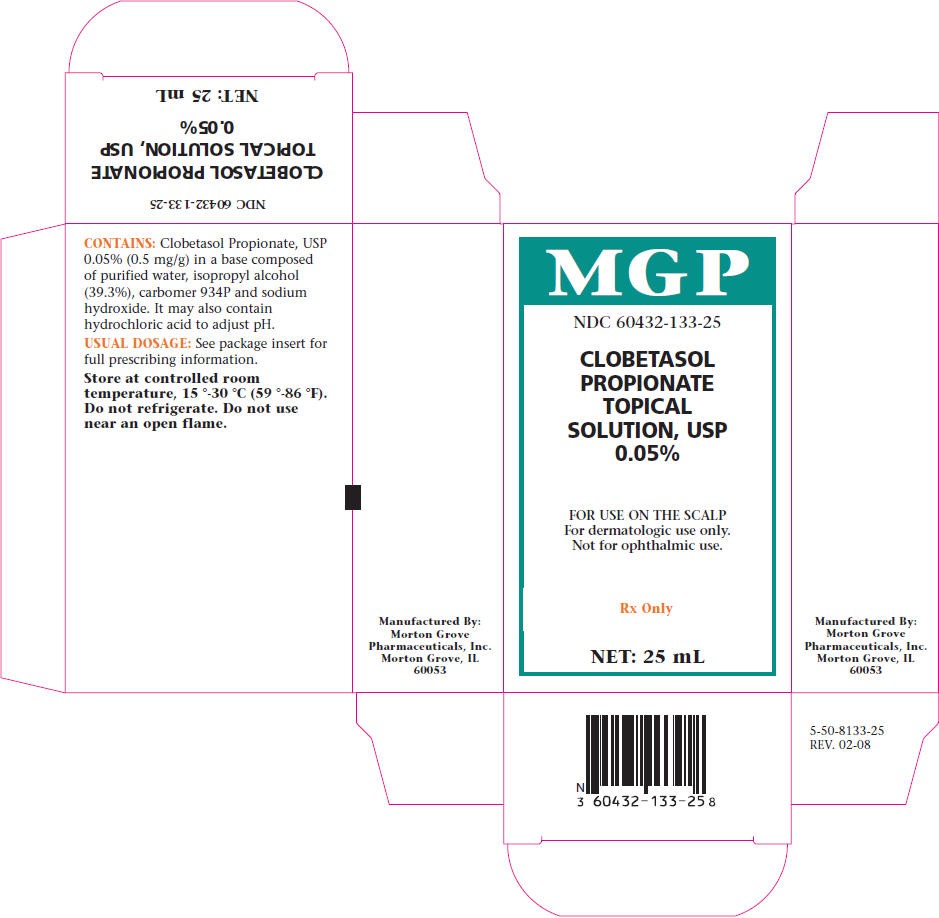Clobetasol Propionate
Morton Grove Pharmaceuticals, Inc.
CLOBETASOL PROPIONATE TOPICAL SOLUTION, USP 0.05%
FULL PRESCRIBING INFORMATION: CONTENTS*
- CLOBETASOL PROPIONATE DESCRIPTION
- CLINICAL PHARMACOLOGY
- CLOBETASOL PROPIONATE INDICATIONS AND USAGE
- CLOBETASOL PROPIONATE CONTRAINDICATIONS
- PRECAUTIONS
- CLOBETASOL PROPIONATE ADVERSE REACTIONS
- OVERDOSAGE
- CLOBETASOL PROPIONATE DOSAGE AND ADMINISTRATION
- HOW SUPPLIED
- PRINCIPAL DISPLAY PANEL - 25 mL Bottle Carton
FULL PRESCRIBING INFORMATION
(potency expressed as clobetasol propionate)
FOR USE ON THE SCALP
For Dermatologic Use Only-
Not for Ophthalmic Use.
CLOBETASOL PROPIONATE DESCRIPTION
Clobetasol propionate topical solution contains the active compound clobetasol propionate, a synthetic corticosteroid, for topical dermatologic use. Clobetasol, an analog of prednisolone, has a high degree of glucocorticoid activity and a slight degree of mineralocorticoid activity.
Chemically, clobetasol propionate is 21-Chloro-9-fluoro-11β,17-dihydroxy-16β-methylpregna-1,4-diene-3,20-dione 17-propionate, and it has the following structural formula:

Clobetasol propionate has the molecular formula C25H32CIFO5 and a molecular weight of 466.98. It is a white to cream-colored crystalline powder insoluble in water.
Clobetasol propionate topical solution contains clobetasol propionate 0.05% (0.5 mg/g) in a base composed of purified water, isopropyl alcohol (39.3%), carbomer 934P and sodium hydroxide. It may also contain hydrochloric acid to adjust pH.
CLINICAL PHARMACOLOGY
The corticosteroids are a class of compounds comprising steroid hormones secreted by the adrenal cortex and their synthetic analogs. In pharmacologic doses, corticosteroids are used primarily for their anti-inflammatory and/or immunosuppressive effects. Topical corticosteroids such as clobetasol propionate are effective in the treatment of corticosteroid-responsive dermatoses primarily because of their anti-inflammatory, antipruritic, and vasoconstrictive actions. However, while the physiologic, pharmacologic, and clinical effects of the corticosteroids are well known, the exact mechanisms of their actions in each disease are uncertain.
Clobetasol propionate, a corticosteroid, has been shown to have topical (dermatologic) and systemic pharmacologic and metabolic effects characteristic of this class of drugs.
Pharmacokinetics
The extent of percutaneous absorption of topical corticosteroids, including clobetasol propionate, is determined by many factors, including the vehicle, the integrity of the epidermal barrier, and the use of occlusive dressings (see DOSAGE AND ADMINISTRATION ).
As with all topical corticosteroids, clobetasol propionate can be absorbed from normal intact skin. Inflammation and/or other disease processes in the skin may increase percutaneous absorption. Occlusive dressings substantially increase the percutaneous absorption of topical corticosteroids (see DOSAGE AND ADMINISTRATION ).
Once absorbed through the skin, topical corticosteroids enter pharmacokinetic pathways similarly to systemically administered corticosteroids. Corticosteroids are bound to plasma proteins in varying degrees. Corticosteroids are metabolized primarily in the liver and are then excreted by the kidneys. Some of the topical corticosteroids, including clobetasol propionate and its metabolites, are also excreted into the bile.
Following repeated nonocclusive application in the treatment of scalp psoriasis, there is some evidence that clobetasol propionate topical solution has the potential to depress plasma cortisol levels in some patients. However, hypothalamic-pituitary-adrenal (HPA) axis effects produced by systemically absorbed clobetasol propionate have been shown to be transient and reversible upon completion of a two-week course of treatment.
CLOBETASOL PROPIONATE INDICATIONS AND USAGE
Clobetasol propionate topical solution is indicated for short-term topical treatment of inflammatory and pruritic manifestations of moderate to severe corticosteroid-responsive dermatoses of the scalp. Treatment beyond two consecutive weeks is not recommended, and the total dosage should not exceed 50 mL/wk because of the potential for the drug to suppress the HPA axis.
This product is not recommended for use in children under 12 years of age.
CLOBETASOL PROPIONATE CONTRAINDICATIONS
Clobetasol propionate topical solution is contraindicated in patients with primary infections of the scalp, or in patients who are hypersensitive to clobetasol propionate, other corticosteroids, or any ingredient in this preparation.
PRECAUTIONS
General
Clobetasol propionate is a highly potent topical corticosteroid that has been shown to suppress the HPA axis at doses as low as 2 g (of ointment) per day.
Systemic absorption of topical corticosteroids has resulted in reversible HPA axis suppression, manifestations of Cushing's syndrome, hyperglycemia, and glucosuria in some patients.
Conditions that augment systemic absorption include the application of the more potent corticosteroids, use over large surface areas, prolonged use, and the addition of occlusive dressings. Therefore, patients receiving a large dose of a potent topical steroid applied to a large surface area should be evaluated periodically for evidence of HPA axis suppression by using the urinary free cortisol and ACTH stimulation tests. If HPA axis suppression is noted, an attempt should be made to withdraw the drug, to reduce the frequency of application, or to substitute a less potent steroid.
Recovery of HPA axis function is generally prompt and complete upon discontinuation of the drug. Infrequently, signs and symptoms of steroid withdrawal may occur, requiring supplemental systemic corticosteroids.
Children may absorb proportionally larger amounts of topical corticosteroids and thus be more susceptible to systemic toxicity (see PRECAUTIONS: Pediatric Use ).
If irritation develops, topical corticosteroids should be discontinued and appropriate therapy instituted. Irritation is possible if clobetasol propionate topical solution contacts the eye. If that should occur, immediate flushing of the eye with a large volume of water is recommended.
If the inflammatory lesion becomes infected, the use of an appropriate antifungal or antibacterial agent should be instituted. If a favorable response does not occur promptly, the corticosteroid should be discontinued until the infection has been adequately controlled.
Although clobetasol propionate topical solution is intended for the treatment of inflammatory conditions of the scalp, it should be noted that certain areas of the body, such as the face, groin, and axillae, are more prone to atrophic changes than other areas of the body following treatment with corticosteroids. Frequent observation of the patient is important if these areas are to be treated.
As with other potent topical corticosteroids, clobetasol propionate topical solution should not be used in the treatment of rosacea and perioral dermatitis. Topical corticosteroids in general should not be used in the treatment of acne or as sole therapy in widespread plaque psoriasis.
Information for Patients
Patients using clobetasol propionate topical solution should receive the following information and instructions:
- This medication is to be used as directed by the physician and should not be used longer than the prescribed time period. It is for external use only. Avoid contact with the eyes.
- This medication should not be used for any disorder other than that for which it was prescribed.
- The treated skin area should not be bandaged or otherwise covered or wrapped so as to be occlusive.
- Patients should report any signs of local adverse reactions to the physician.
Laboratory Tests
The following tests may be helpful in evaluating HPA axis suppression:
-
-
Carcinogenesis, Mutagenesis, Impairment of Fertility
Long-term animal studies have not been performed to evaluate the carcinogenic potential or the effect on fertility of topical corticosteroids.
Studies to determine mutagenicity with prednisolone have revealed negative results.
Pregnancy
Teratogenic Effects
Pregnancy Category C
The more potent corticosteroids have been shown to be teratogenic in animals after dermal application. Clobetasol propionate has not been tested for teratogenicity by this route; however, it is absorbed percutaneously, and when administered subcutaneously it was a significant teratogen in both the rabbit and the mouse. Clobetasol propionate has greater teratogenic potential than steroids that are less potent.
There are no adequate and well-controlled studies of the teratogenic effects of topically applied corticosteroids, including clobetasol, in pregnant women. Therefore, clobetasol and other topical corticosteroids should be used during pregnancy only if the potential benefit justifies the potential risk to the fetus, and they should not be used extensively on pregnant patients, in large amounts, or for prolonged periods of time.
Nursing Mothers
It is not known whether topical administration of corticosteroids could result in sufficient systemic absorption to produce detectable quantities in breast milk. Systemically administered corticosteroids are secreted into breast milk in quantities not likely to have a deleterious effect on the infant. Nevertheless, caution should be exercised when topical corticosteroids are prescribed for a nursing woman.
Pediatric Use
Use of clobetasol propionate topical solution in children under 12 years of age is not recommended.
Pediatric patients may demonstrate greater susceptibility to topical corticosteroid-induced HPA axis suppression and Cushing's syndrome than mature patients because of a larger skin surface area to body weight ratio.
HPA axis suppression, Cushing's syndrome, and intracranial hypertension have been reported in children receiving topical corticosteroids. Manifestations of adrenal suppression in children include linear growth retardation, delayed weight gain, low plasma cortisol levels, and absence of response to ACTH stimulation. Manifestations of intracranial hypertension include bulging fontanelles, headaches, and bilateral papilledema.
CLOBETASOL PROPIONATE ADVERSE REACTIONS
Clobetasol propionate topical solution is generally well tolerated when used for two-week treatment periods.
The most frequent adverse events reported for clobetasol propionate topical solution have been local and have included burning and/or stinging sensation, which occurred in approximately 10% of the patients; scalp pustules, which occurred in approximately 1% of the patients; and tingling and folliculitis, each of which occurred in 0.7% of the patients. Less frequent adverse events were itching and tightness of the scalp, dermatitis, tenderness, headache, hair loss, and eye irritation.
The following local adverse reactions are reported infrequently when topical corticosteroids are used as recommended. These reactions are listed in an approximately decreasing order of occurrence: burning, itching, irritation, dryness, folliculitis, hypertrichosis, acneiform eruptions, hypopigmentation, perioral dermatitis, allergic contact dermatitis, maceration of the skin, secondary infection, skin atrophy, striae, and miliaria. Systemic absorption of topical corticosteroids has produced reversible HPA axis suppression, manifestations of Cushing's syndrome, hyperglycemia, and glucosuria in some patients. In rare instances, treatment (or withdrawal of treatment) of psoriasis with corticosteroids is thought to have exacerbated the disease or provoked the pustular form of the disease, so careful patient supervision is recommended.
OVERDOSAGE
Topically applied clobetasol propionate topical solution can be absorbed in sufficient amounts to produce systemic effects (see PRECAUTIONS ).
CLOBETASOL PROPIONATE DOSAGE AND ADMINISTRATION
Clobetasol propionate topical solution should be applied to the affected scalp areas twice daily, once in the morning and once at night.
Clobetasol propionate topical solution is potent; therefore, treatment must be limited to two consecutive weeks, and amounts greater than 50 mL/wk should not be used.
Clobetasol propionate topical solution is not to be used with occlusive dressings.
HOW SUPPLIED
Clobetasol Propionate Topical Solution, USP 0.05%, a colorless, hazy solution, is supplied in 25 mL and 50 mL plastic squeeze bottles.
Store at controlled room temperature, 15 °–30 °C (59 °–86 °F). Do not refrigerate. Do not use near an open flame.
Rx Only
Prod. No.: 8133
Manufactured By:
Morton Grove Pharmaceuticals, Inc.
Morton Grove, IL 60053
28133
REV. 6-04
PRINCIPAL DISPLAY PANEL - 25 mL Bottle Carton
MGP
NDC 60432-133-25
CLOBETASOL
PROPIONATE
TOPICAL
SOLUTION, USP
0.05%
FOR USE ON THE SCALP
For dermatologic use only.
Not for ophthalmic use.
Rx Only
NET: 25 mL

Clobetasol PropionateCLOBETASOL PROPIONATE SOLUTION
| ||||||||||||||||||||||||||||||||||||||||||||||||||||||||||||||||||||||||||